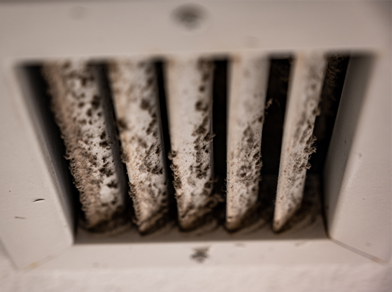Tips to Have a Mold Free HVAC System in Your Home
How to Have a Mold Free HVAC System
If the problem of mold keeps reoccurring, please consult with a mold remediation professional.
Your heating, ventilation, and air conditioning system (HVAC) are designed to heat and cool, freshen, clean, and dehumidify the air in your home for your protection and comfort. When the system ceases to provide one or more of these functions it can lead to a mold infestation.
A serious mold infestation is hard to eradicate and can be very harmful to your family; do not wait—call a professional.
Since it is so serious, let’s consider some ways to make sure mold does not become a problem inside your home. Let’s start with your HVAC system.
Humidity Regulation is the Key to a Mold Free HVAC System
The U.S. Consumer Product Safety Commission determines the ideal humidity for indoor air is between 30 and 50% humidity; expect between 30-40% in the winter and between 40 and 50% in the summer months.
Mold needs three things to grow: moisture, organic matter (it’s not picky), and a dark place, with little to no sunlight. Keeping the humidity low throughout the house restricts the places mold can grow. The indoor air should not feel “sticky,” even on summer days with high humidity outdoors. Use bathroom exhaust fans when showering. If it does feel “sticky,” call your HVAC professional.
Preventative Maintenance Promotes a Mold Free HVAC System
The second thing mold needs are organic material. Mold can bloom on wall paint, chalk, or wooden doors, but it can also feast on collected dust and dander. Matter of fact, the mold pollen will most likely travel together with dust, just waiting for moisture to activate it.
Make sure that you change air filters regularly, every three months at a minimum. Have an HVAC professional service your unit regularly, annually is recommended. Make sure your ductwork is cleaned as needed.
A preventative maintenance inspection can remove dust and repair components that contribute to water leaks. Prevention is much more effective—and safer than remediation.
Mold Removal
Even with these measures, it is not uncommon to find small quantities of mold. So how can you safely remove it?
- If the affected area is larger than 9 square feet, the problem is large enough to call a mold remediation professional. Smaller areas can be cleaned with proper preparation and technique.
- Mold spores can be harmful to your respiratory system; be very aware of the danger. Take the precaution of wearing a mask and gloves before cleaning or scrapping mold away.
Find the right cleaning supplies to keep a Mold Free HVAC System
Mold elimination products are readily available. They generally consist of harsh chemicals, so make sure you wear a mask and have good ventilation for the fumes.
If you are looking for an environmentally friendly cleaning solution, start with soap and water; sometimes that is all that is needed. Another easy remedy is baking soda and water; it kills even black mold and acts as a bleaching agent. Since you are near the mold, always wear a mask.
If you have asthma, allergies, or other breathing issues, it is best for you to stay away and let someone else take care of the problem.
Throw Out Food Items
As mold grows on food, it is reproducing well beyond what you see. Some molds produce a toxin, known as mycotoxins, which will make you very ill. If you see mold on a food item, consider it lost and dispose of it; it is not worth the risk.
Interested in a Mold Free HVAC System?
Let us know how we can help with your indoor air quality concerns and creating a Mold Free HVAC System, call AllCool AC & Heating at 281-238-9292 or contact us via email.
